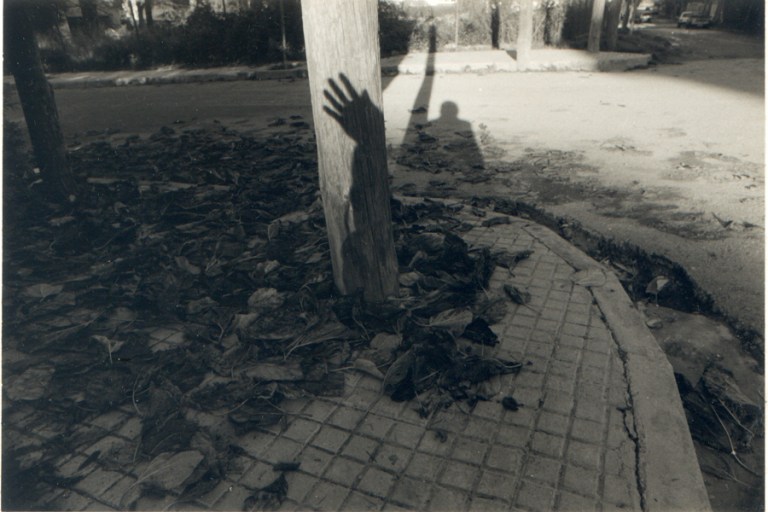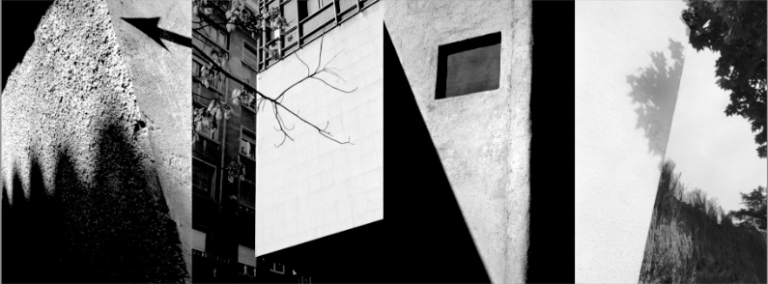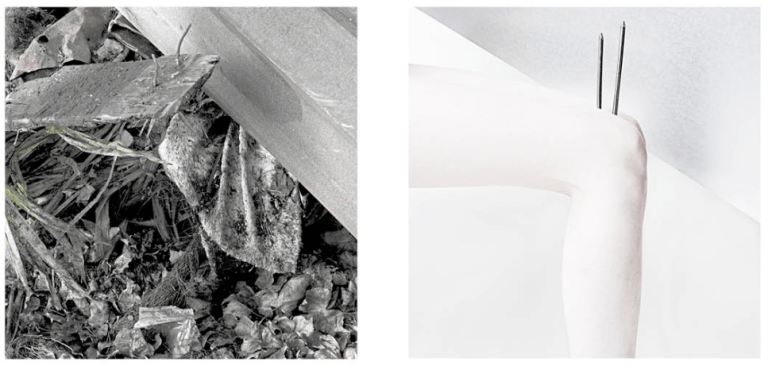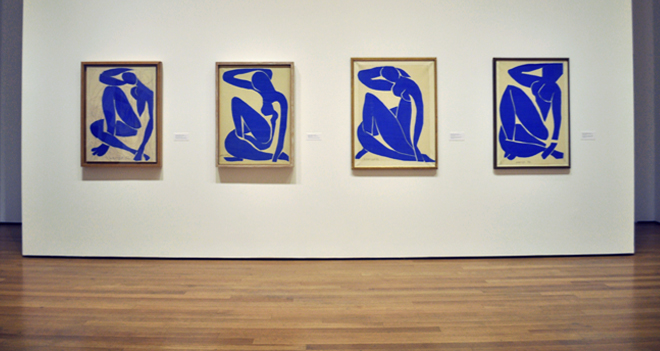 February 28: Photography bends to many uses.
February 28: Photography bends to many uses.
Today Laura Bonnefous opens her Out of Line at La Fontaine Obscure Galerie, 24 av. Henri Poncet, Aix-en-Provence, France and Žiga Kariž begins his show Freud! Marx and I are coming! at Photon Gallery, Zieglergasse 34, Vienna, Austria. Today is also the date in 1953 that Mariano Zuzunaga was born in Lima, Peru.
Zuzunaga migrated to Barcelona in 1973 having learnt photography from an uncle and commencing to make photographs on the street in Spain; small observations that slip into consciousness. Very likely influenced then by his love of the work of Ralph Gibson and André Kertesz, his work was aligned with an international style in photography emanating from the USA and UK, since it was from those countries that the very few photography publications then came.

But it is displacement, as in the shadow in this 1987 street photograph, that becomes a preoccupation in Zuzunaga’s work right up to the present time, through numbers of iterations. A performing musician and composer as well as a photographer, Zuzunaga trained with Argentine pianist Diana Schneider and later with Spaniard Ana Rosa Landa, and composing from improvisation in collaboration with the Peruvian percussionist Manongo Mujica.
Accordingly, the following contrapicados (low-viewpoint) architectural views, which both make use of the negative space of the sky, have the effect of shifting visual octaves; the first of these teases forward a phantom shape in front of nested outlines, which on inspection are rows of bricks at each floor level that form regular squares. The second, a grid, presents a syncopated array of black and white irregular shapes, the coda for which turns out to be a passage of just four images repeated and rotated four times.
Figurative images from 1999 and 2000 take this idea of slippage across an underlying grid still further…
…then compounded in montages of heavily shadowed architectural images that are cleverly linked through content and contorted, inter-folding counterchange.

“Laura Bonnefous offers us a photographic, sculpture-like practice.” So says the website of L’Oeil de Photographie in an article from February 24 for her show Out of Line at La Fontaine Obscure Galerie. More accurately, and a little more elegantly, one might say she makes photographs of fashion, which is really temporary sculpture:
It is true that sometimes my work is on the border between art and fashion, I particularly enjoy working with the designers. Fashion is a universe that attracts me because of its complexity, its relation to the body, its proximity, its intimacy. These are key notions in my work and I like to think that fashion can also invoke art and even mingle with it…let’s hope that the designers will come to connect with artists who I believe have real things to bring to fashion.
This she emphasises by separating the fashion from its purpose as clothing to re-configure the garment and the model in a novel relationship. The character projected by her carefully selected, resolutely stern models is formed from their negotiation of quite severe tableaux in which the fashion items become exacting protagonists and which require their strictly aligning themselves to the backdrops and props.
Bonnefous employs the performance tactics of Melanie Manchot and gives her fashion permission to be as absurdly contrary as Erwin Wurm’s One-Minute Sculptures. In this she is well practiced. To look back in her oeuvre is to find several approaches being applied. In Relics of 2014, fashion is absent; the flat backgrounds and the poses merely hinting at couture, for which disused, outdated tools serve proxy. The same discomfort and dis-ease prevails, a sense that these tools impose a perverse stress test on the human subjects.
In the series Speak with Silence she practices the cool high-key tonality of Out of Line which won her Lauréate First Prize in Prix Picto de la Mode, of 2015.


Here she turns every tone and hue up several notches to the verge of pure white and to the point at which flesh almost merges with the geometric props, which challenge the contours of the body as much as its pain threshold. The diptychs rhyme the props with the accidental encounters of similar forms in the garbage dump and building site:
I spent part of my youth in construction sites, these places were for me playgrounds, hybrid spaces that questioned me. At the beginning of my artistic practice, I explored our relationship to contemporary constructions through installation or performance.
In a recent series Périphéries Intérieures the high-key effect is shifted toward the mid tones by introducing an atmosphere of fog that pervades the environmental shots and invades the studio.
Périphéries Intérieures formulates a vision of territory transformed by man. It is a personal and sensory approach to landscape, a way for me to rethink the place of man in front of his environment. This is a project I have been thinking about for several years.

“I’m not looking for the spectacular, I’m running away from it.” Laura Bonnefous.
We paid attention when Walter Benjamin got particular about the ‘aura’ of the original artwork and revealed how it was emancipated by mechanical reproduction, got told when John Berger peeled away the capitalist and colonialist ideologies from the canon of western art, justifiably subjecting it to a feminist critique, and pointing out that Ingres’ Grande Odalisque was no different from pornography in showing “a woman’s body to the man looking at the picture. This picture is made to appeal to his sexuality. It has nothing to do with her sexuality.” Now Žiga Kariž puts the finger on Henri Matisse.


Kariž’s pastiches are paste-ups; images borrowed from internet porn sites, printed as a jigsaw of 10×15 cm prints and glued to a backdrop painted in chroma-key greens…so you can have these girls wherever you like; just add your desired background! Up close the genital detail is explicit.
Žiga Kariž’s Freud! Marx and I are coming! is the deliberate provocation of a renegade, a man who in 2007 changed his name to that of the Slovenian right-wing politician and Slovenia’s then prime minister, Janez Janša, as did his colleagues, media artist Davide Grassi, and theatre director Žiga Kariž. That act, they maintain, had personal motives and no links with art; however, it marked the beginning of a long-term project that occupied the three artists’ public activities and private lives alike. In the 2010 election, Janša was ousted, and while Kariž reverted to his original name, Hrvatin and Grassi chose to continue living and working under the name of Janez Janša.
Now he is back to being Žiga Kariž, who was born in 1973 in Ljubljana, Slovenia, across the Adriatic from Italy, who grew up under the communist regime of Tito, and was exposed to American television in the relatively liberal society. The economy became more prosperous as he finished high school in 1992, during his homeland’s successful revolutionary move toward independence and the European union, amidst a flood of images; commercial television, advertising, glossy magazines, digital photography and desktop computers, and pornography. Now he is a professor at the Academy of Fine Arts and Design, University of Ljubljana and his work is exhibited worldwide, including at the Venice Biennial (2003, 2011) and the São Paulo Biennial (2002).
Both the art historical pedigree and the personal references then are clear, and in comes Freud to shove (aggressive?) Heineken (male?) empties into a full Nutella (infantile?) jar (female?) which obligingly oozes its sweet brownness in a psychoanalytically interesting manner. Marx re-appropriates the red Heineken star logo for a couple of Warholian hand-painted cardboard plinths which stand before the collages in this show.
The contortions involved in marrying high art and low, consciously pre-digested, outdated psychology and politics, and personal references, would be athletic if it were not for the fact that pornography is pornography, but not art, high or low, just as Uncle John warned!























